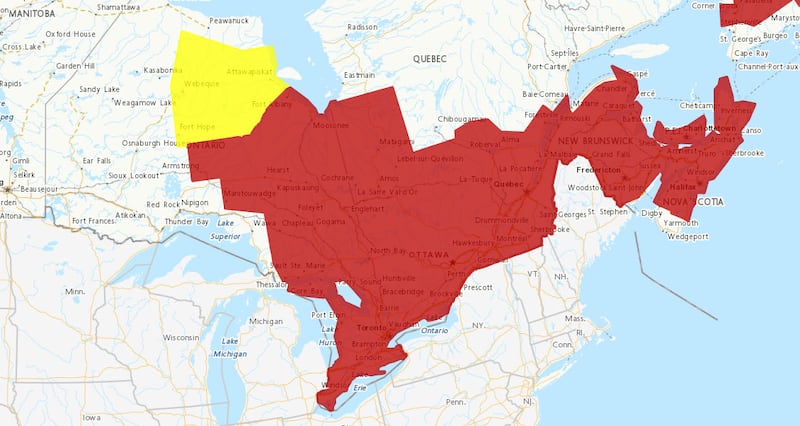A “multi-day heat event” continues in Toronto and surrounding areas with daytime highs of 32 to 35 degrees Celsius that feel more like 37 to 40 with the humidity.
Currently, Environment Canada has issued a heat warning for much of Ontario, including Toronto, Hamilton, Burlington-Oakville, Caledon, Halton Hills-Milton, Mississauga-Brampton, Newmarket-Georgina-Northern York Region, Niagara Falls-Welland-Southern Niagara Region, Pickering-Oshawa-Southern Durham Region, St. Catharines-Grimsby-Northern Niagara Region, and Vaughan-Richmond Hill-Markham.
 Heat warning Aug. 10 Ontario Most of Ontario is under a heat warning on Aug. 10. (Environment Canada map)
Heat warning Aug. 10 Ontario Most of Ontario is under a heat warning on Aug. 10. (Environment Canada map)
The national weather agency says overnight lows in the GTA will run between 20 to 23 C.
This hot weather is expected to continue through Tuesday or possibly into Wednesday, it said.
Relief should come on Tuesday evening as a cooler air mass is expected to arrive, bringing an end to the heat event.
Environment Canada says, however, that there is a possibility that eastern Ontario and the Greater Toronto and Hamilton Area will see hot and humid conditions into Wednesday.
 Another day of extreme heat in Toronto, but relief is right around the corner
Another day of extreme heat in Toronto, but relief is right around the corner
Heat warnings are issued when very high temperature or humidity conditions are expected to pose an elevated risk of heat illnesses, such as heat stroke or heat exhaustion.
People should note that hot and humid air can cause deteriorating air quality and may result in the Air Quality Health Index approaching the high-risk category.
“Take action to protect yourself and others – extreme heat can affect everyone’s health. Determine if you or others around you are at greater risk of heat illness,” the agency said.
People are being advised to check on older adults, those living alone, and other at-risk people in-person or on the phone multiple times a day, and to keep an eye out for early signs of heat exhaustion in yourself and others.
They may include headache, nausea, dizziness, thirst, dark urine, and intense fatigue.
Anyone who experiences these symptoms is urged to stop their activity and drink water.
Heat stroke is a more severe medical emergency.
People are advised to call 9-1-1 or their emergency health provider if you, or someone around you, is experiencing red and hot skin, dizziness, nausea, confusion, and a change in consciousness.
“While you wait for medical attention, try to cool the person by moving them to a cool place, removing extra clothing, applying cold water or ice packs around the body. Drink water often and before you feel thirsty to replace fluids,” says Environment Canada.
“Close blinds, or shades and open windows if outside is cooler than inside. Turn on air conditioning, use a fan, or move to a cooler area of your living space. If your living space is hot, move to a cool public space such as a cooling centre, community centre, library or shaded park.”
During the etreme heat, resident should follow the advice of their public health authority.
Some of the other ways to beat the heat include planning and scheduling outdoor activities during the coolest parts of the day, limiting direct exposure to the sun and heat, and wearing lightweight, light-coloured, loose-fitting clothing and a wide-brimmed hat.
“Never leave people, especially children, or pets inside a parked vehicle. Check the vehicle before locking to make sure no one is left behind.”
Stay hydrated during this heat warning.
If you need them, water trucks are available at:
💧Nathan Phillips Square
💧Garrison Common
💧Mel Lastman Square
💧Sankofa Square
Get tips to keep cool in hot weather, here: https://t.co/Se7PES8oPy pic.twitter.com/peWWQ4Wf84
— City of Toronto 🇨🇦 (@cityoftoronto) August 10, 2025
